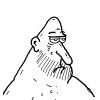Thomas Jefferson, bound by slavery
Published in Senior Living Features
A life-size bronze statue of Thomas Jefferson sits at the visual heart of the new National Constitution Center exhibition exploring slavery and the eloquent advocate of "life, liberty, and the pursuit of happiness."
Behind the third president, inscribed on an enormous curving red wall, are more than 600 names -- from "Abby" to "Zachary" and 11 labeled simply "name unknown."
These are the enslaved people owned by Jefferson and held at Monticello, his Virginia plantation, over the course of a lifetime. No aspect of his life was untouched by slavery.
His home was built by his chattels. They nursed and cared for his children. Most historians agree they bore his children as well.
They made his nails and barrels, planted, tended, and harvested his crops, crafted his furniture, and cooked his food. They cared for him during illnesses, at the end time watched over his lifeless body, and dug his grave when he died in 1826.
Jefferson -- whom slavery made possible -- called it a "deplorable entanglement" and proclaimed his desire to end it. Yet there he stands, surrounded by the red wall of names, in the center of the exhibition "Slavery at Jefferson's Monticello," which opens Wednesday at the Constitution Center on Independence Mall.
"This is such a rich, detailed story," said Susan R. Stein, senior curator and vice president for museum programs at Monticello. "We know a tremendous amount about Thomas Jefferson from the written record. We know a tremendous amount about slavery from the written record. . . . There's so much there, the exhibition, as rich as it is, is just a summary."
Monticello, which is owned and operated by the Thomas Jefferson Foundation, cocurated the exhibition with the Smithsonian's National Museum of African American History and Culture.
"Jefferson himself said 'we have the wolf by the ear,' " said Rex M. Ellis, the African American museum's associate director for curatorial affairs, alluding to Jefferson's metaphor for America and slave labor. " 'We can neither hold him nor safely let him go.' The conflict Jefferson had with slavery is embodied in that statement."
The exhibition vividly portrays Jefferson's life intertwined with slavery. Furniture, farm implements, tools, tableware, nails, ceramics, all made or used by Jefferson's enslaved workers and families, share space with the rarefied artifacts owned by the master -- silver spectacles (designed and worn by Jefferson); a carved ivory chess set, acquired in France, with red pieces representing Africans and white pieces representing Frenchmen; Jefferson's walking stick and silver pen; his inkwell in the shape of Voltaire's head; his silver cutlery and porcelain sugar bowl.
But what brings home the intimate and distressing nature of chattel slavery in Jefferson's life is the highlighting of six enslaved families who lived and worked at Monticello in his lifetime.
The most famous is the Hemings family; more than 70 members are associated with the plantation, five generations bound by slavery.
The family arrived when Jefferson inherited Elizabeth Hemings, who was owned by his father-in-law, and her 10 children. Most historians agree that her children were fathered by her owner, the father of Jefferson's wife, Martha.
Sally Hemings was one of them.
Jefferson took 14-year-old Sally to France as a companion for his own daughter in 1787. By 1802 newspaper reports circulated regarding their relationship, and stories continued to make the rounds through the next two centuries. In 1998, DNA testing showed a link between Jefferson males and Hemings descendants.
At this stage, most scholars, considering the DNA results and the reams of circumstantial and documentary evidence, believe Jefferson fathered one and probably all of Sally Hemings' six children (two died as infants).
In addition to the Hemings family, the exhibition focuses on the Gillette family, the Herns, the Fossetts, the Grangers, and the Hubbard brothers. Their lives at Monticello are illustrated by archaeological evidence amassed over the last four decades.
But it is perhaps the last section of the exhibition, called "Getting Word," that brings into focus the impact of Monticello. The Jefferson Foundation has been engaged for some time in tracking down descendants associated with the plantation and recording their stories.
It is here we learn that Joseph Fossett, grandson of Elizabeth Hemings, was freed in Jefferson's will, only to have his wife and children sold to cover Jefferson's debts. Fossett worked tirelessly and eventually bought freedom for his family, moved to Ohio, and helped establish the Underground Railroad there. His descendants fought in the Civil War, and one, William Monroe Trotter, joined with W.E.B. Du Bois in founding the Niagara Movement, a forerunner of the NAACP.
Members of the Woodson family, many of whom live in the Philadelphia area, once attributed their lineage to Jefferson. But the 1998 DNA testing found no link.
Byron Woodson, 66, who wrote A President in the Family in 2001, now accepts the DNA results.
"I'm a realist and I'm honest," he said.
His son, Byron Woodson II, 36, said Jefferson was not an issue for him. He believes Sally Hemings is an ancestor and he takes great pride in the fact that an early Woodson woman became one of the first African American women to graduate from college (Oberlin, 1856) and went on to become the first black woman to teach college (Wilberforce, 1859).
"When I grew up, it wasn't about [the Jefferson-Hemings] controversy," said the younger Byron Woodson. "It was about 'look at all these awesome black people we're descended from. Let's get together and celebrate that!' "
EXHIBITION
Slavery at Jefferson's Monticello
Wednesday through Oct. 19 at the National Constitution Center, 525 Arch St.
Tickets: $8-$14.50
215-409-6600 or constitutioncenterorg.
215-854-5594
@SPSalisbury
(c)2014 The Philadelphia Inquirer
Visit The Philadelphia Inquirer at www.philly.com
Distributed by MCT Information Services
(c) The Philadelphia Inquirer






Comments